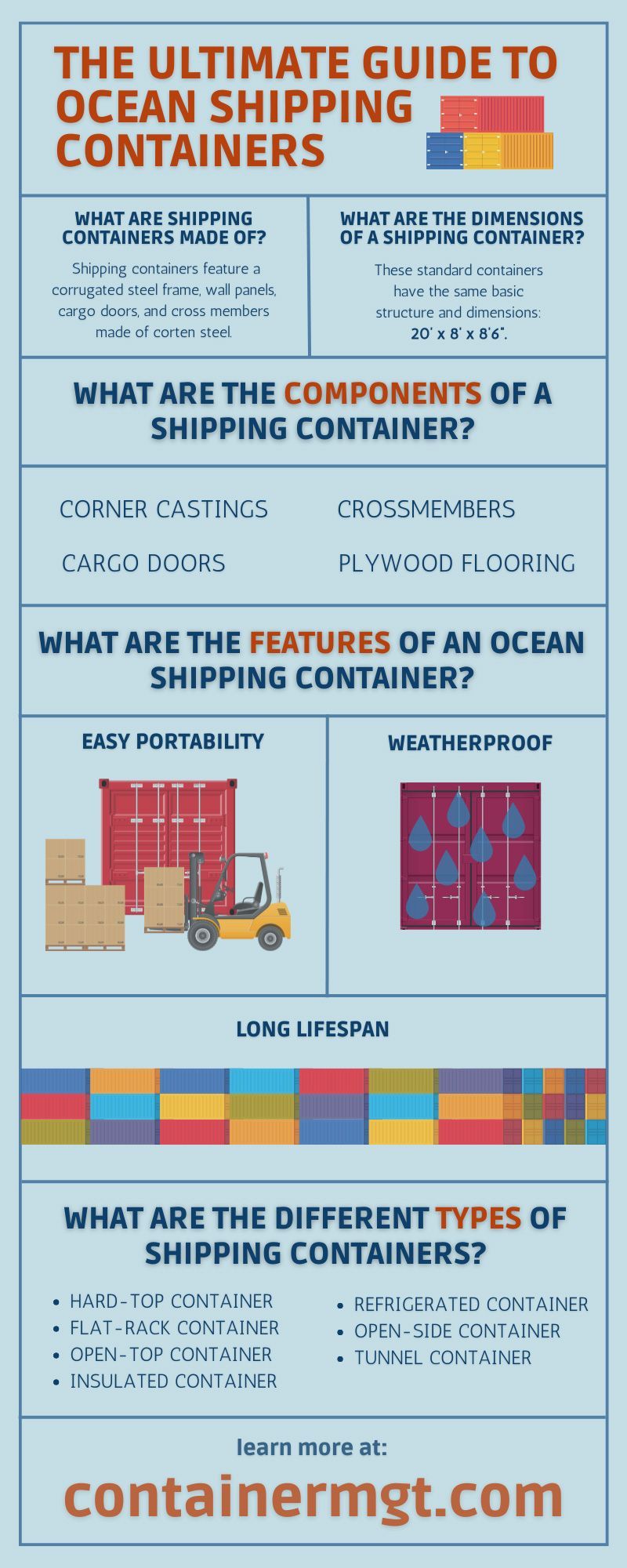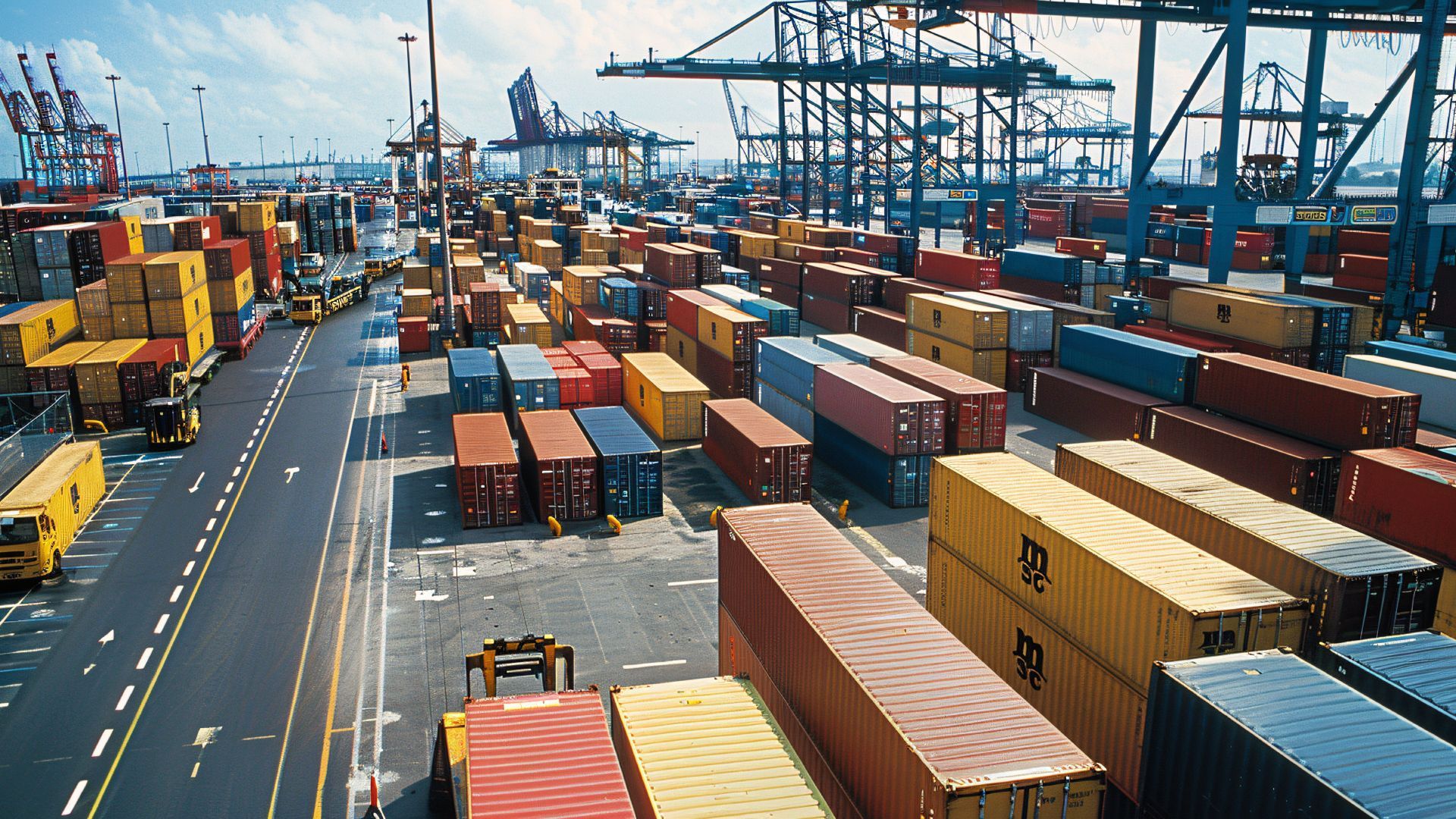Sea Containers (The Ultimate Guide)
Written by Susan Nalevac | March 07, 2023
While a shipping container may seem like a simple steel box, they’re much more complex structures. If you want to learn more about ocean shipping containers, check out our ultimate guide below, which details a shipping container’s materials, dimensions, components, and more.
In This Article:
What Are Shipping Containers Made Of?
First, we’ll go over the basics of shipping containers, like what they’re made of. Shipping containers feature a corrugated steel frame, wall panels, cargo doors, and cross members made of corten steel.
Corten steel is different from other materials because it’s weldable and rust-resistant. Naturally, for metal boxes that spend a lot of time traveling over saltwater oceans, there’s a significant advantage to corrosion-resistant steel. Even if there is a chip in the paint of a shipping container, the corten steel may form a thin layer of rust, but no deeper, which can prevent structural damage.
What Are the Dimensions of a Shipping Container?
While shipping containers come in all shapes and sizes, most are dry-rack or standard containers. These standard containers have the same basic structure and dimensions: 20’ x 8’ x 8’6”.
The 20-foot container is the most common length for the standard unit, but there are also 40-foot containers with the same dimensions for buyers to choose from. But length is the only distinction between 20 and 40-foot containers—their widths and heights are universal.
What Are the Components of a Shipping Container?
While shipping containers may seem like simple steel boxes, they contain crucial components that every container owner should know about. The main elements are the corner castings, cross members, doors, and flooring.
Corner Castings
The corner castings of a shipping container are critical to its structural integrity and strength. Shipping containers are constructed so that the corner castings are used by cranes to lift and transport them.
The corners are also the connection points between one container and another—so when containers get stacked on one another, all the weight is on the corners instead of the roofs and floors. Without sound corner castings, a shipping container is much less reliable.
Crossmembers
On the bottom of a shipping container are cross members—strips of corrugated corten steel that are equally spaced and run underneath the container’s floor. The cross members offer structural support for the container and create a space between the ground the container rests on and the container floor.
This extra gap between the ground and floor helps prevent water and moisture from seeping into the container floor from underneath and causing rust. The container’s cross members are essential to the stability of the container and the quality of the floor—if the steel cross members get rusted or damaged, it will likely lead to a sagging or warped floor inside the container.
Cargo Doors
Depending on the type of container, there may be multiple sets of doors in different sizes, but the common standard container features just one set of heavy cargo doors. Cargo doors protect the cargo from weather and thieves with formidable strength and durability.
Shipping container cargo doors feature a unique locking mechanism to prevent theft and create a watertight seal to keep moisture out. If the cargo doors get rusted or damaged, they can be difficult to open/close and destroy the door’s watertight seal or locking mechanics.
Plywood Flooring
Lastly, the inside of an ocean shipping container features marine-grade plywood flooring. While bamboo flooring is slowly gaining popularity, marine-grade plywood is still by far the most common flooring material.
The biggest concern with a container’s flooring is dry rot and mold destroying the plywood, so container owners should always inspect the container floor for any signs of moisture and rust that could damage its structural integrity.
What Are the Different Types of Shipping Containers?
As discussed, there are many different types of shipping containers besides the standard dry-rack construction. Specialty containers are useful when transporting cargo that’s too big, awkwardly shaped, or needs to get unloaded/loaded differently than typical cargo.
Some examples of specialty shipping containers include:
- Hard-top container
- Flat-rack container
- Open-top container
- Insulated container
- Refrigerated container
- Open-side container
- Container with double doors both ends
What Are the Features of an Ocean Shipping Container?
Due to their materials, construction, and design, ocean shipping containers have many features that make them convenient for worldwide travel, long-term storage, and many other applications.
Easy Portability
The prime feature of an ocean shipping container is that it’s easy to transport. As discussed, shipping containers have standardized dimensions, making them easy to transport and move no matter what port or mode of transportation they take.
Shipping containers are designed for intermodal transportation, meaning they can get transported by truck, rail, sea, and air. Because containers have universal dimensions, they can get transported from a truck to a train and a ship quickly and efficiently.
Weatherproof
Shipping containers must be weatherproof to ensure that the cargo it’s transporting from one port to another worldwide makes it there safely without weather damage. The corrosion-resistant corten steel ensures it can handle salty seawater, and the watertight seal keeps the ocean and weather away from the container’s cargo.
The weatherproof durability and watertight seal of containers also make them beneficial for other non-shipping purposes. It’s one of the many reasons container-based structures for homes and businesses have become such familiar sights.
Long Lifespan
Since shipping containers get constructed with such durable materials, they can serve for over a decade on a shipping line and many decades more on dry land. Typically, a container that’s taken care of will spend around 15 years on a shipping line before it’s retired.
After it’s removed from shipping, containers can get used for container-based structures for homes and businesses and still last for many decades on dry land if they’re well maintained.
Conclusion
We hope our ultimate guide to ocean shipping containers has been informative and helpful. If you’re in the market for a container, Container Management, Inc. has many cargo containers in Houston, TX, for sale and in other locations nationwide.
Contact our expert staff to learn more about shipping containers and to find one that fits your business or personal needs today.





